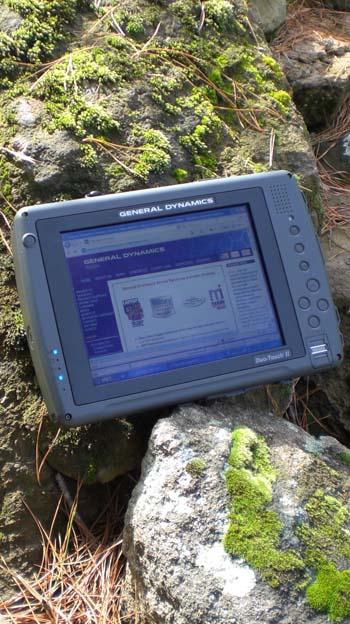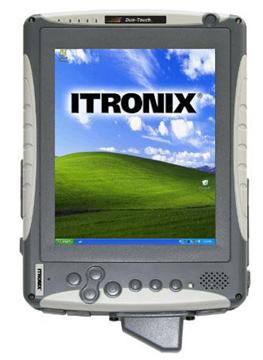The Duo-Touch® II Tablet PC is the latest in a long line of fully-rugged Tablet PCs designed specifically to enable secure, reliable, mobile computing in environmentally-challenging work environments. This feature rich computing platform features dual-touch operating modes enabling you to switch effortlessly between active digitizer and passive touchscreen operations. General Dynamics Itronix, the company behind the Itronix Duo-Touch, has made some improvements to the Tablet PC and now it provides a better performance, along with a good (read bigger) display screen.
Renamed to Intronix Duo-Touch 2 PC, the small-sized computer boats an Intel processor, more specifically a Core Duo U2500, and the memory RAM can go from 512MB up to 2GB. The TFT display screen now measures 8.4-inches, and includes a technology to make it easy to view the content while using it outdoors.
Other features include two types of hard-drives: either Solid State with 32GB as the maximum capacity, or a normal (2.5”) HD with 120GB; plus Wi-Fi for an internet connection, GPS to know where you are located, and bluetooth to use a headset or transfer files from/to a cellphone.
Daylight Viewable Display of the Intronix Duo-Touch PCMobile vertical market computers like the GD-Itronix Duo-Touch II are often used outdoors. This means the display must be readable in broad daylight. The pursuit of outdoor readability has been sort of a Holy Grail of rugged computer manufacturer and different technologies have been tried over the years. While one might think that display brightness is the key, brightness alone is not enough. The real problem is reflection. If the amount of light reflected by the display is as much or more than the light emitted by the backlight, then the display cannot be read. So contrast becomes an issue.
 LCD manufacturers define contrast ratio as the ratio between the whitest pixel and the blackest pixel in a dark room. Such ratios can be 1000:1 or more. They are also meaningless outdoors. According to our technology editor Geoff Walker, the real-world, or effective, contrast ratio outdoors can be determined with a rule-of-thumb formula where effective contrast ratio = 1 + (emitted light / reflected light). Effective contrast ratios are generally between 1:1, which is unreadable, and 20:1 which is as good as it can get and comparable to a typical newspaper in sunlight.
LCD manufacturers define contrast ratio as the ratio between the whitest pixel and the blackest pixel in a dark room. Such ratios can be 1000:1 or more. They are also meaningless outdoors. According to our technology editor Geoff Walker, the real-world, or effective, contrast ratio outdoors can be determined with a rule-of-thumb formula where effective contrast ratio = 1 + (emitted light / reflected light). Effective contrast ratios are generally between 1:1, which is unreadable, and 20:1 which is as good as it can get and comparable to a typical newspaper in sunlight.
Emitted light the strength of the backlight is important but it is also a mixed blessing. It is generally measured in candela per meter squared and usually called nits. Average notebook backlights are about 200 nits. A high bright display may have as much as 1,000 nits. This draws a lot of power and can wash out pixels, making even dark ones look grayish.
The key to a daylight readable display therefore is in reducing reflection. That is relatively simple for a standard LCD, but much more difficult for displays with touch screens as they add more layers and thus more reflective surfaces. To reduce reflection, manufacturers use anti-reflective coatings and special polarizers. The exact layering and bonding methods of all those surfaces determines overall reflection, and this is where the patent-pending comes into play. In conjunction with a strong (but not excessively bright so as to significantly reduce battery life) backlight, it cuts overall display reflectivity to about 7:1, which Walker describes as "adequately readable in sunlight."
Remarkably well unless you have unrealistic expectations. Take the Duo-Touch outdoors on a bright day, and it remains totally readable in the shade. Go into direct sunlight and it becomes a bit more difficult as the sun can still reflect in the display surface. So why not add one of those matte-looking anti-glare coatings on top of everything else? Because GD-Itronix found that an anti-glare coating reduced performance and test users felt an anti-glare coated screen was not as sharp. As is, even facing the sun the screen remains readable, though you may have to position it so there is no direct reflection from the sun.
The display of the Intronix Duo Touch II isn't perfect, and current technology doesn't allow one that is, at least not outdoors.
What do u think about a viewing angel? Ever since the BOE Hydis wide viewing angle LCDs became available in Tablet PCs, we've been raving about them as they let you view the screen from any angle without any color shifts or washing out. BOE Hydis does not make an 8.4-inch display. The one GD-Itronix uses has a perfect near-180-degree horizontal viewing angle, but a much narrower one when you tilt the unit vertically. That means you have to hold the computer at a proper angle to avoid color shifts. This would be an issue in a notebook, but much less so in a tablet that can easily be positioned for best possible viewing.

Key Features
Properties of the Itronix Duo-Touch PC II
 Brightness adjustment is either automatic or via buttons. The manual mode isn't immediately obvious: You use Function and the "rotate" key to increase brightness, and Function and the "security" key to decrease it.
Brightness adjustment is either automatic or via buttons. The manual mode isn't immediately obvious: You use Function and the "rotate" key to increase brightness, and Function and the "security" key to decrease it.
In automatic mode there is the very handy control panel shown to the left. It lets you set backlight brightness levels in response to ambient lighting conditions as measured by the computer's light sensor that sits on the right side of the screen just above the control buttons.
The light sensor measures light in lux. Direct sunlight ranges from 30,000 to 100,000 lux. Outdoors in the shade you may encounter a few hundred to a couple of thousand lux. Indoors, you may have as little as 30 lux or as much as 500 under a bright reading lamp. The panel lets you set automatic brightness for four ranges. When the sensor detects a different lighting environment, it waits a few seconds, then adjusts brightness in steps. Even if you set the brightness to maximum for all levels, it's educational to watch the lux readout. You learn something about lighting intensity.
The same utility also lets you assign alternate functions to each of the hardware buttons to the right of the LCD.
Specifications of the Itronix Duo Touch 2
| Dimensions |
|
| Weight |
|
| Processor/Memory |
|
| Storage |
|
| Power |
|
| Display |
|
| Pointing Device |
|
| Operating System |
|
| Interfaces |
|
| Audio |
|
| Integrated Wireline Communications |
|
| Optional Integrated Wireless Communications |
|
| Hot Keys |
|
| Options |
|
| Environmental |
|
| Warranty |
|

